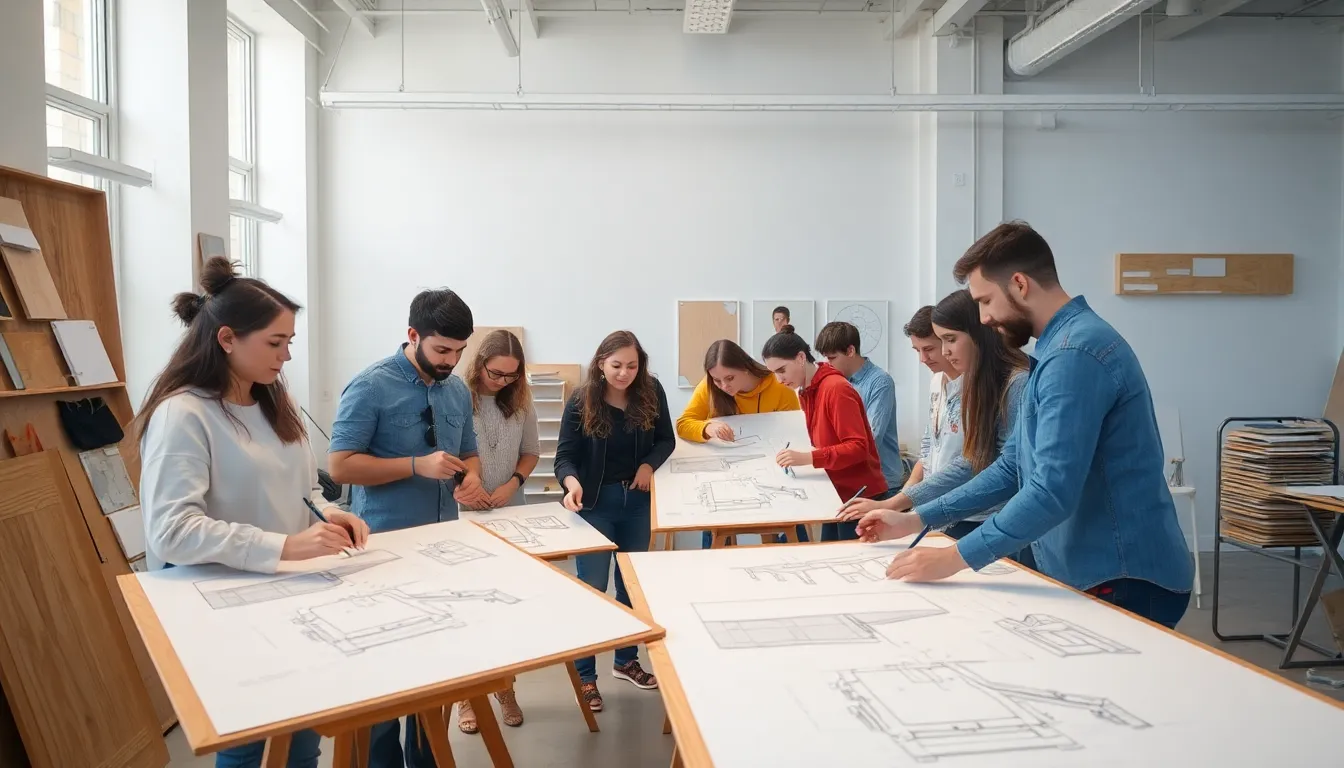In a world where bland furniture reigns supreme, imagine being the hero who brings style and creativity to every living room. A furniture design course can transform anyone from a casual doodler into a master of aesthetics and functionality. With the right guidance, they’ll learn to craft pieces that not only look good but also make people wonder how they ever lived without them.
Picture this: a coffee table that doubles as a conversation starter or a chair so comfy it might just win a Best Supporting Actor award. Enrolling in a furniture design course isn’t just about learning to build; it’s about unleashing creativity and revolutionizing spaces. So why settle for ordinary when extraordinary is just a course away?
Furniture Design Course
Furniture design courses provide essential knowledge and skills for aspiring designers. These programs help individuals transform creative ideas into tangible pieces of art.
Types of Furniture Design Courses
Short-term workshops focus on specific skills, allowing participants to dive deeply into techniques like woodworking or upholstery. Degree programs offer comprehensive education in design principles, materials, and manufacturing processes. Online courses enable flexible learning, helping students balance personal commitments. Certification programs provide targeted training for professionals seeking to advance their careers.
Benefits of Taking a Furniture Design Course
Courses enhance creativity, encouraging students to think outside the box. Learning design theories builds a strong foundation, allowing individuals to apply concepts effectively. Networking opportunities with industry professionals can lead to valuable connections. Practical experience gained through projects builds confidence and competence in designing functional pieces. Access to resources, tools, and techniques broadens skills, preparing students for diverse design challenges.
Skills Developed in Furniture Design

Furniture design courses cultivate a diverse skill set essential for aspiring designers. Students gain both creative and technical abilities that empower them to bring innovative ideas to life.
Creative Skills
Creative skills form the backbone of furniture design. Students learn to develop unique concepts and visualize how different elements interact. They master the art of sketching, which aids in expressing their design ideas clearly. Learning to use mood boards helps in curating color palettes and materials that resonate with their vision. Additionally, the exploration of trends and styles encourages originality, allowing designers to craft furniture that tells a story and enhances aesthetics in living spaces.
Technical Skills
Technical skills play a crucial role in the furniture design process. Understanding materials is pivotal; students explore various types like wood, metal, and textiles to choose the best fit for their designs. They become proficient in design software that facilitates creating detailed plans and 3D models. Knowledge of manufacturing processes enriches their capability to collaborate effectively with craftsmen and manufacturers. Finally, learning about ergonomics ensures that furniture not only looks good but also provides comfort and functionality, vital for any successful design.
Choosing the Right Furniture Design Course
Selecting an ideal furniture design course requires careful consideration of several factors.
Factors to Consider
Identify personal goals before choosing a course. Focus on aspects such as skill level and desired outcomes. Budget constraints impact decisions significantly and should align with course fees. Course duration determines how quickly skills are acquired. Evaluate the curriculum to ensure it covers the essential areas of furniture design, including creative techniques and technical skills. Research instructor credentials, as experienced professionals provide valuable insights. Networking opportunities also play a vital role in advancing a career, so consider programs that facilitate connections with industry experts.
Online vs. In-Person Courses
Online courses offer flexibility, allowing students to learn at their own pace. Accessibility to resources is a significant advantage with online formats. Conversely, in-person courses provide hands-on experience through direct interaction with instructors and peers. Many individuals prefer the immediacy of feedback available in a classroom setting. Consider personal learning styles when weighing options. Online platforms often incorporate multimedia resources, which can enhance the educational experience. The choice ultimately depends on lifestyle, personal preferences, and career aspirations, ensuring that the selected format best supports individual learning needs.
Career Opportunities in Furniture Design
The field of furniture design offers diverse career paths with exciting prospects. Individuals can explore various roles that cater to different skills and interests within the industry.
Job Roles in the Industry
Furniture designers often work in several positions. They may become product designers, focusing on creating innovative furniture pieces. Interior designers frequently collaborate with furniture designers to ensure the aesthetics of spaces. Additionally, furniture manufacturers hire specialists to oversee production processes. Some professionals choose to freelance, allowing them to build a portfolio while working directly with clients. Others might pursue roles in retail, helping customers select suitable furniture for their needs. Design educators also play a vital role by teaching aspiring designers the intricacies of the craft.
Potential Salary Expectations
Salary expectations in furniture design can vary significantly based on experience and role. Entry-level positions can yield annual salaries ranging from $40,000 to $55,000. With experience, designers can see their earnings increase to between $55,000 and $80,000. Senior roles, including lead designers or design directors, often command salaries from $80,000 to $120,000, depending on company size and project scope. Freelancers may charge hourly rates of $25 to $150, influenced by their expertise and reputation. Overall, the potential for growth in this industry remains substantial, as demand for skilled designers continues to rise.
Conclusion
Enrolling in a furniture design course opens doors to a world of creativity and innovation. It empowers individuals to transform their ideas into functional art that enhances everyday living spaces. With the right course, aspiring designers gain essential skills and knowledge that not only elevate their craft but also prepare them for a thriving career in the industry.
As the demand for skilled furniture designers continues to grow, pursuing this path can lead to exciting opportunities and financial rewards. Whether through hands-on workshops or comprehensive degree programs, each learning experience contributes to a designer’s journey. Embracing this educational journey can ultimately lead to a fulfilling career that blends passion with purpose.

